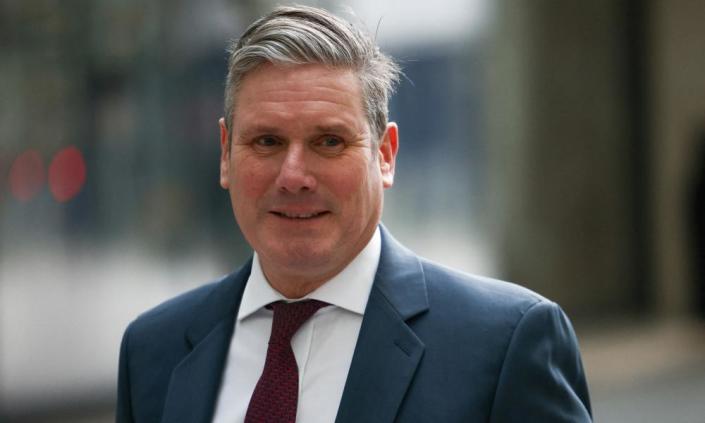Miranda Bryant and Jon Ungoed-Thomas
Sat, 18 February 2023

Photograph: Ben Stansall/AFP/Getty Images
More people are depending on food banks than ever before in Britain, new figures show, as “ever-increasing” numbers of households – including pensioners, NHS staff and teachers – seek help amid the cost of living crisis.
New research by the Independent Food Aid Network (Ifan), shared with the Observer, found that almost 90% of food banks surveyed reported increased demand in December 2022 and January 2023 compared with a year earlier. Half of the 85 organisations running 154 food banks that responded said if demand rose further they would either have to cut support or turn people away.
The Trussell Trust, which with more than 1,300 food banks is the UK’s biggest provider, expects this winter will have been its busiest ever, warning in November that food banks were at “breaking point”. Between April and September alone it distributed 1.3m emergency food parcels – a third more than the same period in 2021 and over 50% more than pre-pandemic.
Figures published last week by the Office for National Statistics showed how despite inflationary pressures easing, the cost of living crisis is still raging. Food inflation is at 16.7% and the cost of gas is nearly 130% higher than a year ago. The Office for Budget Responsibility forecast in November that households’ disposable income would fall by 4.3% in 2022-23, the largest drop since comparable records began in 1956.
A slump in wages in real terms and soaring inflation have triggered the most widespread strikes in the public sector in decades. A ballot of more than 45,000 junior doctors closes on Monday, with results expected to be announced later in the day.
Food banks are struggling to meet record demand from people who are in work – including NHS staff and teachers – the Ifan research found. More than 80% reported supporting a significant number of people for the first time, while many said demand was growing among pensioners and families with babies.

Donations at a Community for Foods centre in Edinburgh.
Photograph: Peter Summers/Getty Images
Sabine Goodwin, Ifan coordinator, said: “It’s very clear that people have been trying to muddle through the winter on credit and are now building up debts that will push people over the edge.” Accusing the government of “unsustainable and unethical” reliance on charitable food aid, she said that without a change of approach there will be “nowhere for people to turn”.
Cost of living increases were given as the biggest problem, followed by inadequate wages and waiting times for initial universal credit payments. A third of independent food banks said benefit sanctions and deductions were a driving factor.
Many food banks are also reporting issues with burnout among staff and volunteers. Judith Vickers, from Lifeshare in Manchester, said: “Staff are reporting burnout, heavy caseloads, and a constant stream of new referrals. We are coping, but the level of demand is relentless. Volunteers often feel that we can’t do enough for people.”
Many of those who have turned to food banks are workers who are going out on strike. Industrial action by NHS staff still enjoys strong public support. Nurses were backed by 64% of the public for their strike action, a rise of 7 percentage points since early January, according to the latest Opinium Research poll for the Observer. Ambulance workers are supported by 60% of the public and rail workers are supported by 39%.
Related: Half of NHS trusts providing or planning food banks for staff
The BMA has warned the government that if its junior doctors’ ballot succeeds, there will be a 72-hour full walkout next month, with action across all NHS services, including emergency care.
In a speech to be delivered at a conference in Bristol today, Professor Philip Banfield, BMA chair of council, will warn Rishi Sunak and health secretary Steve Barclay that they need to ensure a fair pay deal and “rescue the NHS from the brink”.
A government spokesperson said: “We recognise the pressures of the rising cost of living, which is why we delivered £1,200 of direct support to millions of households last year, including £400 towards energy costs, and will be providing a further £1,350 of support to the most vulnerable households in 2023-24.
“Our energy price guarantee is also saving the typical household another £900 this winter, we are increasing benefits and the state pension in line with inflation at 10.1% from April, and our household support fund is helping people with essential costs.”
A Department of Health and Social Care spokesperson said: “As part of a multi-year deal we agreed with the BMA, junior doctors’ pay has increased by a cumulative 8.2% since 2019-20. We also introduced a higher pay band for the most experienced staff and increased rates for night shifts.
“The health and social care secretary has met with the BMA and other medical unions to discuss pay, conditions and workload. He’s been clear he wants to continue discussing how we can make the make the NHS a better place to work for all.”
Sabine Goodwin, Ifan coordinator, said: “It’s very clear that people have been trying to muddle through the winter on credit and are now building up debts that will push people over the edge.” Accusing the government of “unsustainable and unethical” reliance on charitable food aid, she said that without a change of approach there will be “nowhere for people to turn”.
Cost of living increases were given as the biggest problem, followed by inadequate wages and waiting times for initial universal credit payments. A third of independent food banks said benefit sanctions and deductions were a driving factor.
Many food banks are also reporting issues with burnout among staff and volunteers. Judith Vickers, from Lifeshare in Manchester, said: “Staff are reporting burnout, heavy caseloads, and a constant stream of new referrals. We are coping, but the level of demand is relentless. Volunteers often feel that we can’t do enough for people.”
Many of those who have turned to food banks are workers who are going out on strike. Industrial action by NHS staff still enjoys strong public support. Nurses were backed by 64% of the public for their strike action, a rise of 7 percentage points since early January, according to the latest Opinium Research poll for the Observer. Ambulance workers are supported by 60% of the public and rail workers are supported by 39%.
Related: Half of NHS trusts providing or planning food banks for staff
The BMA has warned the government that if its junior doctors’ ballot succeeds, there will be a 72-hour full walkout next month, with action across all NHS services, including emergency care.
In a speech to be delivered at a conference in Bristol today, Professor Philip Banfield, BMA chair of council, will warn Rishi Sunak and health secretary Steve Barclay that they need to ensure a fair pay deal and “rescue the NHS from the brink”.
A government spokesperson said: “We recognise the pressures of the rising cost of living, which is why we delivered £1,200 of direct support to millions of households last year, including £400 towards energy costs, and will be providing a further £1,350 of support to the most vulnerable households in 2023-24.
“Our energy price guarantee is also saving the typical household another £900 this winter, we are increasing benefits and the state pension in line with inflation at 10.1% from April, and our household support fund is helping people with essential costs.”
A Department of Health and Social Care spokesperson said: “As part of a multi-year deal we agreed with the BMA, junior doctors’ pay has increased by a cumulative 8.2% since 2019-20. We also introduced a higher pay band for the most experienced staff and increased rates for night shifts.
“The health and social care secretary has met with the BMA and other medical unions to discuss pay, conditions and workload. He’s been clear he wants to continue discussing how we can make the make the NHS a better place to work for all.”



















